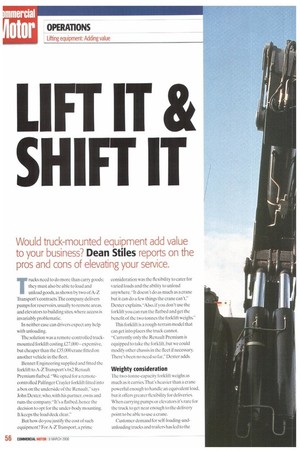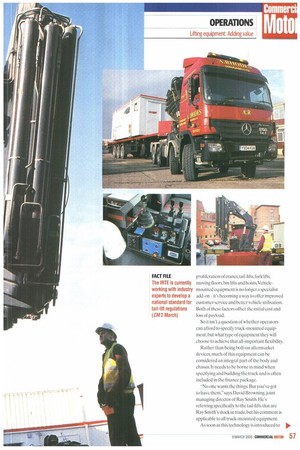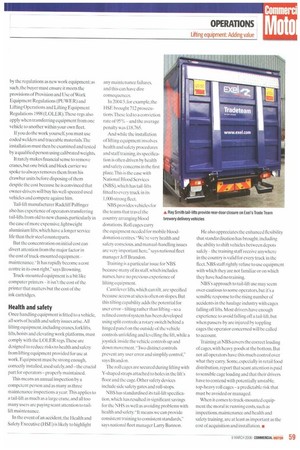LIFT T SHIFT IT
Page 56

Page 57

Page 58

Page 59

If you've noticed an error in this article please click here to report it so we can fix it.
Would truck-mounted equipment add value to your business? Dean Stiles reports on the pros and cons of elevating your service.
Trucks need to do more than carry goods: they must also be able to load and unload goods, as shown by two of A-Z Transport's contracts. The company delivers pumps for reservoirs, usually to remote areas, and elevators to building sites, where access is invariably problematic.
In neither case can drivers expect any help with unloading.
The solution was a remote-controlled truckmounted forklift costing£27,000 — expensive, but cheaper than the £35,000 crane fitted on another vehicle in the fleet.
Bennet Engineering supplied and fitted the forklift to A-Z Transport's 6x2 Renault Premium flatbed. "We opted for a remotecontrolled Palfinger Crayler forklift fitted into a box on the underside of the Renault," says John Dexter, who, with his partner, owns and runs the company."It's a flatbed, hence the decision to opt for the under-body mounting. It keeps the load deck clear."
But how do you justify the cost of such equipment? For A-Z Transport, a prime consideration was the flexibility to cater for varied loads and the ability to unload anywhere. "It doesn't do as much as a crane but it can do a few things the crane can't," Dexter explains. "Also, if you don't use the forklift you can run the flatbed and get the benefit of the two tonnes the forklift weighs."
This forklift is a rough-terrain model that can get into places the truck cannot. "Currently only the Renault Premium is equipped to take the forklift, but we could modify other chassis in the fleet if necessary. There's been no need so far," Dexter adds.
Weighty consideration the two-tonne-capacity forklift weighs as much as it carries.That's heavier than a crane powerful enough to handle an equivalent load, but it offers greater flexibility for deliveries. When carrying pumps or elevators it's rare for the truck to get near enough to the delivery point to be able to use a crane.
Customer demand for self-loading-andunloading trucks and trailers has led to the proliferation of cranes, tail-lifts, forklifts, moving floors, bin lifts and hoists Vehiclemountedequipment is no longer a specialist add-on— it's becoming a way to offer improved customer service and better vehicle utilisation. Both of these factors offset the initial cost and loss of payload.
So it isn't a question of whether operators can afford to specify truck-mounted equipment, but what type of equipment they will choose to achieve that all-important flexibility.
Rather than being bolt-on aftermarket devices, much of this equipment can be considered an integral part of the body and chassis. It needs to be borne in mind when specifying and building the truck and is often included in the finance package.
No one wants the things. But you've got to have them," says David Browning, joint managing director of Ray Smith. He's referring specifically to the tail-lifts that are Ray Smith's stock in trade, but his comment is applicable to all truck-mounted equipment.
As soon as this technology is introduced to any sector, its use proliferates rapidly. In the construction industry almost every delivery requires the operator to unload and place the goods where required on site. Common examples are crane-loaders with grabs for bricks and blocks, or forklifts to move plasterboard and bagged cement into dry storage areas.
"Forklifts are fitted on rigids [as well as semitrailers] and although three axles give a better payload, lightweight models are as popular on 4x2s,says Stuart Bennet of Bennet Engineering. Despite the weight penalty, rough-terrain models account for a high proportion of sales; this confirms operator comments about having to get goods further from the truck than is possible with a crane.
Forklifts offer other advantages: operators can use curtain-sided bodies—essential for weather-sensitive loads such as plasterboard — and they can be left behind when not needed to regain some of the payload penalty.
-Compared with a lorry-mounted crane, you have a materials-handling device that is fully independent of the lorry," says Alex White at Manitou, the Texas-based specialist in rough-terrain forklifts. "In the end you save time and money as there is no waiting for a forklift to become available and you can deliver immediately over any terrain even if you are unable to reach the site with the delivery vehicle."
Inevitably, fitting a forklift demands careful calculation to optimise weight distribution and avoid axle overloads. Ballast may have to be carried to avoid weight-distribution problems when running unladen.
Residual values
Truck-mounted forklifts— which, strictly speak ing, are not mounted but carried— have a different impact on residual values when compared with cranes and other permanently mounted equipment.
"With truck-mounted forklifts. it's often better to sell the forklift separately: the residual for the forklift will far exceed that of the vehicle ills mounted on," says White.
"That said, it is difficult to put a figure on forklift residuals. The condition of the forklift will depend on the maintenance during its working life.The 1 wear and tear comes from when the forklift is mounted on the back of the truck due to .;RUEHAU salt and dirt —not when it is being used on the ground."
In general. truck-mounted 1 equipment will contribute r little residual value to a used chassis.The cost and difficulty involved in removal and refitting will inevitably outweigh any advantages of trying to use whatever life the equipment has left on another chassis; this applies even to expensive cranes.
A crane, tail-lift or other loading device is regarded by the regulations as new work equipment; as such, the buyer must ensure it meets the provisions of Provision and Ilse of Work Equipment Regulations (PUWER) and Lifting Operations and Lifting Equipment Regulations 1998 (LOLER). These regs also apply when transferring equipment from one vehicle to another within your own fleet.
If you do the work yourself, you must use coded welders and traceable materials.The installation must then be examined and tested by a qualified person using calibrated weights.
It rarely makes financial sense to remove cranes,but one brick and block carrier we spoke to always removes them from his drawbar units before disposing of them despite the cost because he is convinced that owner-drivers will buy his well-specced used vehicles and compete against him.
Tail-lift manufacturer Radcliff Palfinger also has experience of operators transferring tail-lifts from old to new chassis, particularly in the case of more expensive, lightweight aluminium lifts, which have a longer service life than their steel counterparts.
But the concentration on initial cost can divert attention from the major factor in the cost of truck-mounted equipmentmaintenance. It has rapidly become a cost centre in its own right," says Browning.
Truck-mounted equipment is a bit like computer printers it isn't the cost of the printer that matters but the cost of the ink cartridges.
Health and safety
Once handling equipment is fitted to a vehicle, all sorts of health and safety issues arise. All lifting equipment. including cranes,forklifts, lifts, hoists and elevating work platforms, must comply with the LOLER regs. These are designed to reduce risks to health and safety from lifting equipment provided for use at work. Equipment must be strong enough, correctly installed, used safely, and the crucial part for operatorsproperly maintained.
This means an annual inspection by a competent person and as many as three maintenance inspections a year. This applies to a tail-lift as much as a large crane, and all too many users are paying scant attention to taillift maintenance.
In the event of an accident, the Health and Safety Executive (HSE) is likely to highlight any maintenance failures, and this can have dire consequences.
In 200415. for example, the HSE brought 712 prosecutions.These led to a conviction rate of 95% and the average penalty was i18,765.
And while the installation of lifting equipment involves health and safety procedures and staff training, its specification is often driven by health and safety concerns in the first place.This is the case with National Blood Services (NBS). which has tail-lifts fitted to every truck in its 1,000-strong fleet.
NBS provides vehicles for the teams that travel the country arranging blood donations. Roll cages carry the equipment needed for mobile blooddonation centres. We're very health and safety conscious. and manual-handling issues are very important here," says national fleet manager Jeff Brandon.
Training is a particular issue for NBS because many of its staff, which includes nurses, have no previous experience of lifting equipment.
Cantilever lifts, which can tilt, are specified because access at sites is often on slopes. But this tilting capability adds the potential for user error tilting rather than lifting-so a refined control system has been developed using split controls: a rotary switch behind a hinged panel on the outside of the vehicle controls unfolding and levelling the lift, while a joystick inside the vehicle controls up and down movement. Two distinct controls prevent any user error and simplify control," says Brandon.
The roll cages are secured during lifting with Y-shaped straps attached to holes in the lift's floor and the cage. Other safety devices include side safety gates and roll-stops.
NBS has standardised its tail-lift specification, which has resulted in significant savings for the NHS as well as avoiding problems with health and safety."It means we can provide consistent training to consistent standards," says national fleet manager Larry Bannon. He also appreciates the enhanced flexibility that standardisation has brought, including the ability to shift vehicles between depots safelythe training staff receive anywhere in the country is valid for every truck in the fleet. NBS staff rightly refuse to use equipment with which they are not familiar or on which they have had no training.
NBS's approach to tail-lift use may seem over-cautious to some operators, but it's a sensible response to the rising number of accidents in the haulage industry with cages falling off lifts. Most drivers have enough experience to avoid falling off a tail-lift, but when passers-by are injured by toppling cages the operator concerned will be called to account.
Training at NBS covers the correct loading of cages, with heavy goods at the bottom. But not all operators have this much control over what they carry. Some, especially in retail food distribution, report that scant attention is paid to sensible cage loading and that their drivers have to contend with potentially unstable, top-heavy roll cages-a predictable risk that must be avoided or managed.
When it comes to truck-mounted equipment the moral is: running costs, such as inspections, maintenance and health and safety training, are at least as important as the cost of acquisition and installation. •
































































































































































































